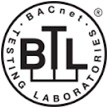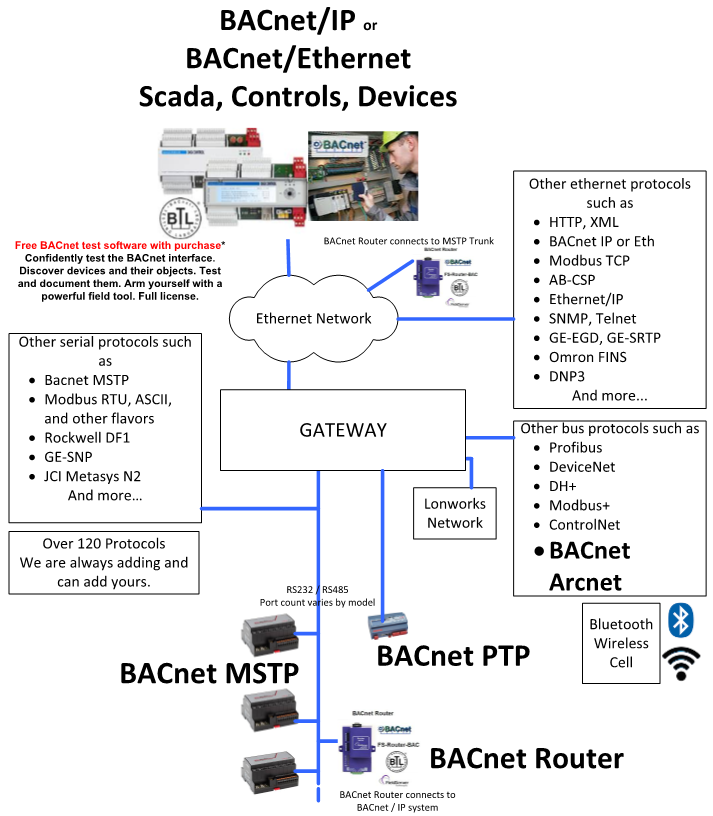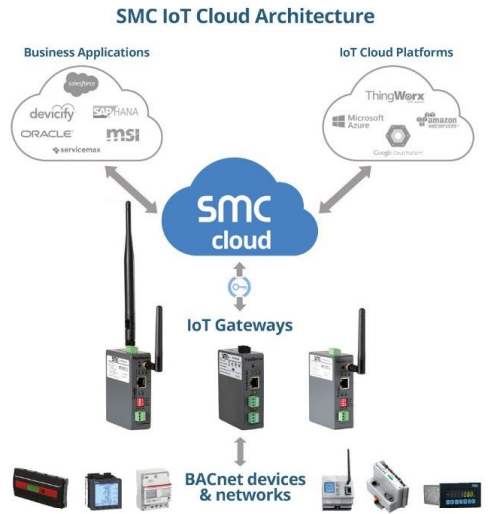The BACnet IoT Gateway provides a connection from BACnet devices and networks to the cloud. This is achieved via a discovery tool built into the hardware for any BACnet/IP or BACnet MS/TP network without any additional dongles or installations needed. BBMD BACnet network discovery is also supported.
The BACnet IoT Gateway comes in three models. The FS-IOT-BAC model offers two RS-485 ports and one Ethernet 10/100 port. The FS-IOT-BACW model has one RS-485 port, one Ethernet 10/100 port and supports Wi-Fi network connection. The FS-IOT-BACC model supports cellular connections as well as all ports and support offered by the FS-IOT-BACW model.
Additionally, Wi-Fi models act as a Wi-Fi access point for modern web-based configuration and remote access from any mobile device without user restrictions.
The BACnet IoT Gateway also includes Monitor View, Historian, and Event Log data analysis features that allow tracking and logging of individual device data points across the connected network in real-time. The BACnet IoT Gateway is cloud-ready and connects with Sierra Monitor’s SMC Cloud.
BACnet IP
The BACnet/IP driver allows the FieldServer to transfer data to and from devices over Ethernet using BACnet/IP protocol. The FieldServer can emulate either a Server or Client.
All information in a BACnet system is represented in terms of objects. The Object_Identifier is a 32-bit code that identifies the type of Object (also identified by the Object_Type Property) and its "Instance" number, which together uniquely identify the Object within its BACnet device. Theoretically, a BACnet device could have over four million Objects of a particular type. The Object_Name is a text string, which has a unique capability.
BACnet devices may broadcast queries for devices that contain Objects with a specific Object_Name. This can greatly simplify project setup.
Every BACnet device must have a Device Object, which provides details about the device and its functionalities to other networked devices. Before engaging in control communications, a BACnet device must acquire pertinent information from the Device Object of the target device. Unlike other Objects, the Instance number of the Device Object must be unique across the entire BACnet internetwork, serving as the device's distinct identifier. This uniqueness facilitates easy identification of the BACnet device during installation and operation.
Standard object types are used to hold real time data and other information. Each Object Type is referenced by a number, for example 0 represents an Analog Input. See Appendix D.1 for abbreviation list.
Each Object consists of a number of prescribed properties, the main property being the Present_Value. Objects are monitored and controlled through their properties.
BACnet MSTP
The BACnet Master-Slave/Token-Passing (MS/TP) driver implements a data link protocol that uses the services of the RS-485 physical layer. See the FieldServer BACnet PIC statement for the level of conformance that this driver implements.
All information in a BACnet system is represented in terms of objects. The Object_Identifier is a 32-bit code that identifies the type of Object (also identified by the Object_Type Property) and its "Instance" number, which together uniquely identify the Object within its BACnet device. Theoretically, a BACnet device could have over four million Objects of a particular type. The Object_Name is a text string, which has a unique capability. BACnet devices may broadcast queries for devices that contain Objects with a specific Object_Name. This can greatly simplify project setup.
BACnet requires one Device Object to be present in every BACnet device. The Device Object makes information about the device and its capabilities available to other devices on the networks. Before one BACnet device starts control-related communications with another, it needs to obtain some of the information presented by the other device's Device Object. Unlike other Objects, the Device Object's Instance number must be unique across the entire BACnet internetwork because it is used to uniquely identify the BACnet devices. It may be used to conveniently identify the BACnet device from other devices during installation.
Standard object types are used to hold real time data and other information. Each Object Type is referenced by a number, for example 0 represents an Analog Input.
Each Object consists of a number of prescribed properties, the main property being the Present_Value. Objects are monitored and controlled through their properties. The Analog Input Object is representative of the Objects involved directly with control elements and many of its Properties reflect this.
IoT Gateway
SMC's secure BACnet IoT Gateways are fully integrated with the SMC Cloud Platform. The gateways enable users to easily connect new and legacy BACnet devices to the cloud. These gateways connect BACnet devices and networks to the cloud via wired (Ethernet) or wireless (Wi-Fi or cell modem support depends on the model selected) installations. BACnet devices can instantly be cloud-enabled to support secure remote device monitoring, control, data collection and alarming.
The gateways provide powerful device discovery and management across both serial and Ethernet BACnet networks. User tools enable easy gateway configuration to deliver BACnet objects to the cloud, either as individual devices or as filtered object groups.
SMC's BACnet IoT Gateways are the fastest and easiest way to cloud-enable BACnet products in the field as well as provide secure remote connectivity to installed fleets of BACnet devices. These gateways are delivered ready to discover, cloud connect and manage any BACnet devices without any programming or mapping (plug and play).
Specifications
Environment
- Operating Temperature: -20 to 70oC (-4 to 158oF)
- Relative Humidity: 10-95% RH non-condensing
Power Requirements
- Intput: 12-24 VDC 0.125A, 12-24VDC 0.25A @12 VDC
- BAC/BACW: Current draw @ 12V, 240mA
- BACC: Current draw @ 12V, 670mA
Physical Dimensions
- Dimensions (WxDxH): 4 x 1.1 x 2.7 in (10.16 x 2.8 x 6.8cm)
- Weight: 0.4 lbs (0.2 Kg)
Other
Web configuration
Toolbox diagnostic utility
DIN rail mount included
Communication
- Baud: 9600, 19200, 34800, 57600, 76800, 115000
- Serial (Galvanic Isolation) Ports: RS485
- Ethernet Port: 10/100baseT, MDIX, DHCP
Approvals
- UL 60950
- IC Canada
- RoHS Compliant
- WEEE compliant
- PTCRB and CTIA
- CE and FCC class B and C part 15
Resources
Learning about BACnet? Want to update your BACnet knowledge? This is a free EBook that will guide you through basic and advanced BACnet topics.
Additional Information
BACnet MSTP to IP
A BACnet Router is used to connect MSTP trunks to BACNetIP systems. The router itself is a device on the IP and on the MSTP side. The router can also act as BBMD device allowing messages to cross from one subnet to another.
BACnet BBMD
BACnet messages cannot cross from one subnet to another except under special circumstances.
Most BACnet sequenc es of messages begin with a broadcast called 'who is'. All devices respond with 'I am'. That is how they are discovered. It is also how many system confirm the device is still there.
Broadcasts can't cross routers (they are blocked) and therefore devices on the other side of a router cannot e discovered.
BBMD is the name of the BACNet technology that resolves these issues. The BACNet ROuter sold by CAS provides BBMD services as do all FieldServer BACNet products when configured as clients.
Logos





